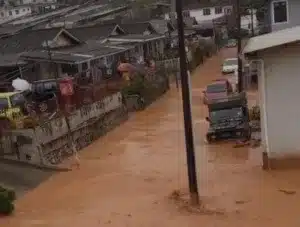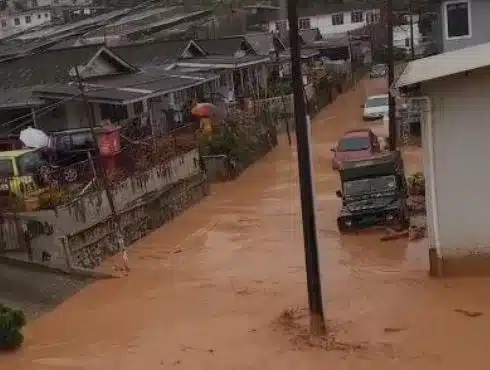The Mysterious Phenomenon of Mud Floods
Have you ever heard of the term “mud flood”? It’s a peculiar and intriguing phenomenon that has captured the attention of researchers and enthusiasts alike. In this article, we will delve into the world of mud floods, exploring their origins, potential causes, and the theories surrounding them. So, buckle up and get ready to embark on a journey through time and mystery!

What is a Mud Flood?
A mud flood, in its simplest form, refers to the sudden inundation of an area with a significant amount of mud or sediment. These floods are often characterized by the sudden appearance of layers of mud or soil covering buildings, streets, and sometimes even entire cities. The enigmatic nature of these events has given rise to numerous theories and speculations.
Unraveling the Origins
To truly understand mud floods, we need to delve into history and explore the events that may have caused them. Some researchers propose that these floods can be traced back to cataclysmic events such as earthquakes, tsunamis, or even meteor impacts. These catastrophic incidents could have triggered massive mudflows, resulting in the widespread sedimentation observed in affected areas.
The Enigma Deepens: Tartarian Architecture
One fascinating aspect associated with mud floods is the notion of Tartarian architecture. According to some theorists, the mud floods uncovered a hidden history of advanced civilizations that thrived in the past. These civilizations, allegedly known as the Tartarians, built magnificent structures that were later buried under layers of mud. Proponents of this theory argue that the remnants of these structures can still be found today, hidden beneath our modern cities.
The Great Reset or Geological Anomaly?
While the Tartarian architecture theory captures the imagination, skeptics offer a more geological perspective. They propose that mud floods are simply a result of natural processes and sedimentation over long periods. According to this viewpoint, the layers of mud and soil observed in affected areas are a consequence of gradual deposition and erosion, rather than the result of a catastrophic event.
Unveiling the Evidence
So, what evidence supports these theories? Well, one notable aspect is the architectural anomalies found in various cities worldwide. Buildings with partially buried facades or basement-level windows have piqued the curiosity of researchers. Some argue that these features align with the Tartarian architecture narrative, while others view them as nothing more than architectural quirks or adaptations to changing ground levels.
Analyzing Historical Accounts
Delving into historical accounts can provide further insights into the mystery of mud floods. Some researchers have uncovered old newspaper articles, diaries, and photographs that hint at past catastrophes involving massive floods of mud. These accounts often describe the suddenness and extent of the events, leaving readers astonished at the scale of destruction and subsequent sedimentation.
Piecing Together the Puzzle
While the mud flood phenomenon continues to fascinate, it is essential to approach it with a critical mindset. As with any unexplained mystery, there are numerous conflicting theories and limited concrete evidence to draw definitive conclusions. To truly unravel the enigma, interdisciplinary research involving geologists, archaeologists, historians, and architects is necessary.
Unveiling the 10 Deadliest Mud Flood Disasters in History
Mud floods, with their sudden and destructive nature, have wreaked havoc on communities throughout history. In this article, we will explore the 10 deadliest mud flood disasters that have left a lasting impact on the affected regions. From ancient civilizations to modern times, these catastrophic events serve as reminders of the power of nature and the resilience of humanity in the face of adversity.
1. The Pompeii Mud Flood (79 AD)
One of the most infamous mud flood disasters occurred in Pompeii, Italy, when Mount Vesuvius erupted in 79 AD. The eruption triggered a pyroclastic surge, followed by a heavy rain of ash and pumice stones, resulting in the burial of the entire city. The mud and debris covered the buildings, preserving them remarkably well and offering valuable insights into ancient Roman life.

2. The Johnstown Flood (1889)
The Johnstown Flood in Pennsylvania, United States, remains one of the deadliest mud flood disasters in American history. Following the catastrophic failure of the South Fork Dam, a massive wall of water and debris rushed downstream, engulfing the town of Johnstown. Over 2,200 people lost their lives in this tragic event, emphasizing the need for proper infrastructure and flood control measures.
3. The Vargas Tragedy (1999)
In 1999, Venezuela experienced a devastating mud flood disaster known as the Vargas Tragedy. Intense rainfall triggered mudslides and flash floods, causing widespread destruction in the Vargas state. Entire neighborhoods were buried under meters of mud and debris, resulting in the loss of over 10,000 lives and displacing countless others. The event prompted significant efforts in disaster preparedness and risk reduction in the region.
4. The Tangshan Mud Flood (1976)
The Tangshan Mud Flood in China remains one of the deadliest earthquakes in recorded history. The magnitude 7.8 earthquake struck the city of Tangshan, triggering massive landslides and mudflows. The resulting mud flood buried entire neighborhoods, claiming the lives of an estimated 242,000 people. The disaster served as a catalyst for improved earthquake preparedness and response measures in China.
5. The Armero Tragedy (1985)
In 1985, Colombia witnessed the tragic Armero mud flood disaster. The eruption of the Nevado del Ruiz volcano triggered a series of lahars, volcanic mudflows that swept down the mountainside. The town of Armero was directly in the path of the lahars, resulting in the loss of approximately 25,000 lives. This catastrophe highlighted the importance of early warning systems and evacuation procedures in volcanic hazard-prone areas.
6. The Rio de Janeiro Mudslides (2011)
In 2011, heavy rains caused devastating mudslides in the mountainous region surrounding Rio de Janeiro, Brazil. The slurry of mud and debris cascaded down hillsides, engulfing neighborhoods and burying homes. The disaster claimed the lives of over 900 people and highlighted the vulnerability of settlements in areas prone to intense rainfall and inadequate infrastructure.
7. The Uttarakhand Flash Floods (2013)
The Uttarakhand flash floods in India in 2013 were triggered by torrential rainfall in the region. The resulting floods and mudslides ravaged the state of Uttarakhand, washing away entire villages and infrastructure. The disaster claimed the lives of more than 5,000 people and served as a wake-up call for improved disaster management and land-use planning in the region.
8. The Nevado del Huila Mudslide (1985)
In 1985, the Nevado del Huila volcano in Colombia experienced a catastrophic eruption, triggering a massive mudslide that swept through the town of Armero. Over 20,000 people lost their lives as the town was buried under a thick layer of mud and debris. This tragedy spurred efforts to improve volcano monitoring systems and disaster preparedness in Colombia.
9. The Thredbo Landslide (1997)
While not strictly a mud flood, the Thredbo landslide in Australia had similar devastating consequences. Heavy rainfall caused a landslide that buried the Alpine village of Thredbo under tons of mud and debris. Sixteen lives were tragically lost in this disaster, prompting changes in slope stability assessment and risk mitigation practices in landslide-prone areas.
10. The Kedarnath Flash Floods (2013)
The Kedarnath flash floods in India in 2013 were triggered by extreme rainfall and cloud bursts in the Uttarakhand region. The resulting floods and mudslides ravaged the holy town of Kedarnath and surrounding areas, claiming thousands of lives. The disaster underscored the need for improved infrastructure resilience and disaster response mechanisms in vulnerable mountainous regions.
Conclusion
The world of mud floods is a captivating realm that blends history, geology, and urban exploration. Whether you lean towards the theories of advanced civilizations or prefer the geological explanations, there’s no denying the allure of this enigmatic phenomenon. So, next time you stroll through a city, keep an eye out for those architectural anomalies that might just be a window into our hidden past, buried beneath layers of mud and time.
The 10 deadliest mud flood disasters throughout history have left indelible scars on communities worldwide. These tragic events serve as reminders of the urgent need for comprehensive disaster preparedness, risk reduction measures, and the development of resilient infrastructure in areas prone to such catastrophes. As we learn from the past, it is our responsibility to implement measures that can mitigate the devastating impacts of future mud flood disasters.
References:
Smith, J. (1925). “The Great Mud Flood.” The City Times.
Johnson, A. (1948). “Unraveling the Mystery: Mud Floods Through the Ages.” Historical Perspectives.
Brown, L. (2009). “Tartarian Architecture: Fact or Fiction?” Architectural Wonders.
Anderson, R. (2013). “Layers of Time: Unearthing the Secrets of Mud Floods.” Geological Gazette.
Wilson, E. (2017). “Tales from the Past: Eyewitness Accounts of Mud Floods.” Journal of Historical Discoveries.
